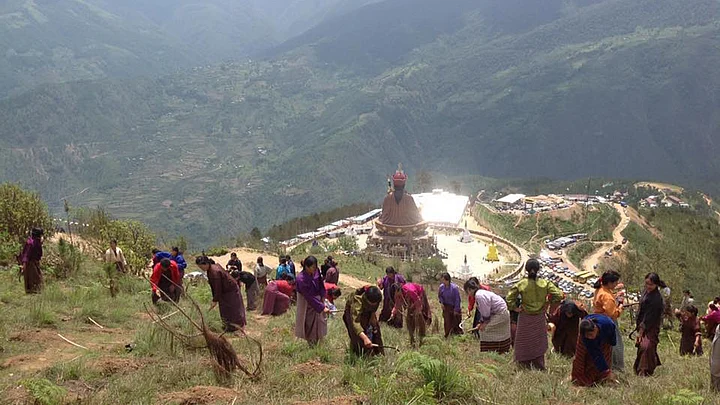Bhutan has continually been ranked as the happiest Asian country. But what makes this tiny country so very zen?
To begin with, being environmentally conscious is certainly one of the factors that keeps Bhutanese people happy. Polluted and sickly surroundings like that of Indian cities often take a toll on the health of the people living in it, and sickness affects temperaments.
In March 2016, at least 1,08,000 saplings were planted across the country as a prayer for the well-being of the crowned prince who was born on 5 February 2016.
Three months later on 1 June, encouraged by the government, Bhutanese women not only planted more trees, but also broke records while doing so.
A hundred women at Takila region of Bhutan planted 49,718 saplings in one hour to beat out 2,100 men who planted 49,672 saplings at Kuenselphodrang in 2015.
But Bhutan doesn’t stop to celebrate its success. On the same day, several other plantation programmes were also arranged to celebrate social forestry day.
At least 50,000 saplings were planted in Dzonkhag, another 10,000 saplings were planted by 350 volunteers at Samarzhingkha, members of Parliament too planted 108 saplings at Debsi Pharka, and yet another 60,000 saplings were generally planted in several parts of the country.
That amounts to 2,77,826 saplings in only the first half of 2016!
When each of these little saplings grow into trees, each of them can absorb as much as 48 pounds of carbon dioxide per year, providing oxygen for four people. Every five percent of tree cover can reduce storm water runoff by approximately two percent and improve water quality by absorbing and filtering rainwater.
And three of these trees planted around buildings can cut air-conditioning costs by up to 50 percent.
In a conventional estimate of a tree’s worth, generally the economic value is taken into account. But in
1979, Indian biologist Professor TM Das attempted to estimate the environmental value of a tree, taking into account net oxygen production and net carbon absorption.
The revised figures show that one tree during 50 years of growth, values itself at $710,260, of which the two pressing environmental issues, removal of SPM, CO2, and SO2) is worth $402, 500, and recycling of water and controlling humidity and air temperature is worth $154,560.
Which is to say that each of the 2,77,826 saplings planted in Bhutan this year will be valued at $1,97,32,86,94,760 (or approximately $100 billion) in their 50 years of growth! And that’s only their environmental worth.
Which makes it quite probable that Bhutan will be retaining its spot as the happiest country for the next five decades.
